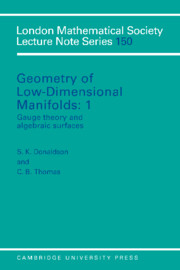Book contents
- Frontmatter
- Contents
- Contributors
- Names of Participants
- Introduction
- Acknowledgments
- PART 1 FOUR-MANIFOLDS AND ALGEBRAIC SURFACES
- PART 2 FLOER'S INSTANTON HOMOLOGY GROUPS
- 6 Instanton homology, surgery and knots
- 7 Instanton homology
- 8 Invariants for homology 3-spheres
- 9 On the Floer homology of Seifert fibered homology 3-spheres
- 10 Za-invariant SU(2) instantons over the four-sphere
- PART 3 DIFFERENTIAL GEOMETRY AND MATHEMATICAL PHYSICS
7 - Instanton homology
Published online by Cambridge University Press: 16 February 2010
- Frontmatter
- Contents
- Contributors
- Names of Participants
- Introduction
- Acknowledgments
- PART 1 FOUR-MANIFOLDS AND ALGEBRAIC SURFACES
- PART 2 FLOER'S INSTANTON HOMOLOGY GROUPS
- 6 Instanton homology, surgery and knots
- 7 Instanton homology
- 8 Invariants for homology 3-spheres
- 9 On the Floer homology of Seifert fibered homology 3-spheres
- 10 Za-invariant SU(2) instantons over the four-sphere
- PART 3 DIFFERENTIAL GEOMETRY AND MATHEMATICAL PHYSICS
Summary
These are notes of the lectures delivered by Andreas Floer at the LMS Symposium in Durham. After a general introduction, the three sections correspond precisely to his three lectures. The reference for the first lecture is [Fl], and for the third [F2] and [F3]. For details of the second lecture see Floer's article in this volume.
The unifying theme behind the topics discussed here is Morse theory on infinite dimensional manifolds. Recall that classical Morse theory on finite-dimensional manifolds, as developed by M. Morse, R. Thorn, S. Smale and others, can be viewed as deriving the homology of a manifold from a chain complex spanned by the critical points of a Morse function, with boundary operator defined by the flow lines between critical points. This was the approach taken by J. Milnor in his exposition of Smale's work on the structure of high-dimensional smooth manifolds [M].
This point of view was described in the language of quantum field theory by E. Witten [W]. To him, critical points are the groundstates of a theory, and flow lines between them represent tunneling by “instantons”. These ideas form the background against which Floer developed the theories described in these lectures, in which the manifold considered is infinite-dimensional. In the first of these theories the manifold under consideration is the space of gauge equivalence classes of (irreducible) connections on a bundle over a 3-manifold. The gradient lines are given, literally, by the instantons of 4-dimensional Yang-Mills theory. In the second theory the manifold considered is the loopspace of a symplectic manifold, and the gradient lines or instantons are Gromov's pseudoholomorphic curves [G].
- Type
- Chapter
- Information
- Geometry of Low-Dimensional Manifolds , pp. 115 - 124Publisher: Cambridge University PressPrint publication year: 1991
- 2
- Cited by



